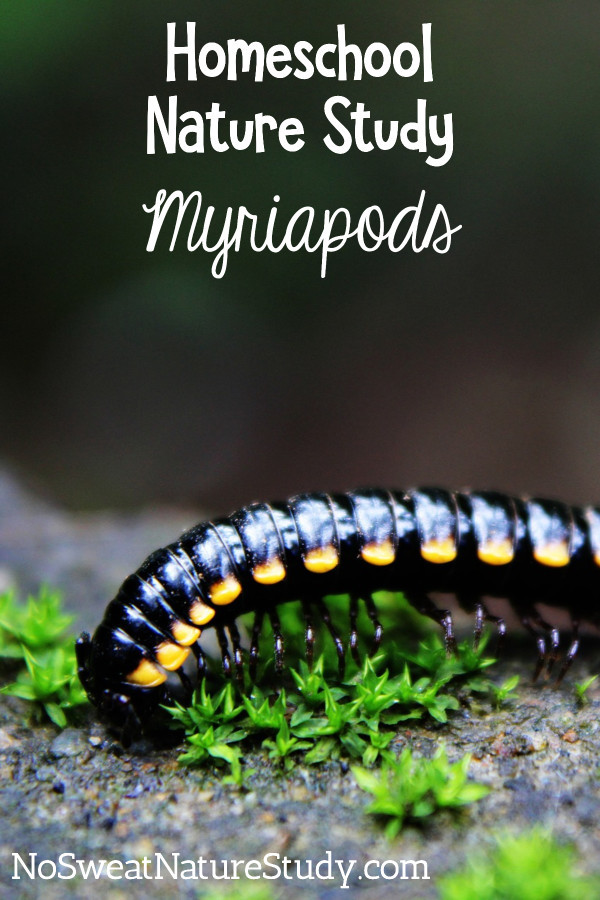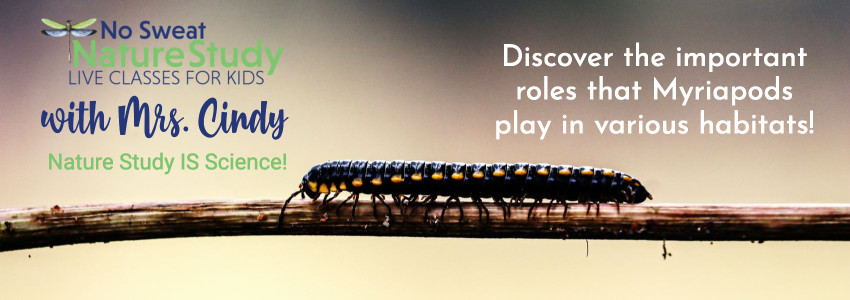Myriapod Nature Study for Homeschoolers
We’re venturing into a slightly spine-tingling topic on the podcast this week. Are you ready for myriapod nature study? The creepy appearance of centipedes and millipedes makes this topic perfect for a mid-October science lesson!
As your family listens to the podcast episode, you’ll be encouraged to picture a serene autumn forest. Amidst the rustling leaves and chirping birds, watch out for a mysterious creature! What is it, and should we be afraid? Join Mrs. Cindy to take on the mystery of wild, leggy creatures that play an essential role in nature.

This post contains affiliate links.
Myriapod Nature Study
These intriguing invertebrates, myriapods, include the well-known millipedes. Despite the name, they don’t actually have a thousand legs, but they do have a lot. Learn that number as well as how fast they move, as you discover some of their intriguing defense mechanisms, too. As nature’s recyclers, millipedes play an important role in nature. They break down dead plant material, showcasing their vital role as decomposers.
Their cousins, centipedes, are just as vibrant in the myriapod community. Found in moist habitats amongst leaf clutter and in the soil, these wormlike critters can be very surprising to find. Don’t be fooled, though, they aren’t worms. They aren’t insects either. Myriapods are their very own group of segmented, multi-legged animals.

Free Nature Observation Printable Packet for All Seasons
No matter what time of year you’re listening to this episode of the No Sweat Nature Study Podcast, here’s a printable pack of nature observation activities for every season of the year!
Myriapod Nature Study Video Class
In the upcoming No Sweat Nature Study LIVE video class about myriapods, discover more about millipedes and their agile relatives, centipedes. Learn which animal would win in a footrace, and find out more about the physical and chemical defense mechanisms that keep them safe against predators. Of course, you’ll determine just how careful you need to be the next time you happen upon a myriapod in your own backyard.
The nature journaling assignment includes practice with outline drawings, as well as labeling the important anatomy of centipedes and millipedes.

Nature Study Curriculum
Ready to go deeper with nature study in your homeschool? Let Ms. Cindy guide your students on a nature exploration complete with live lessons, nature journaling activities, and a huge video library of nature study classes. Check out No Sweat Nature Study LIVE Membership!
Even more amazing than beautiful butterflies fluttering about is the incredible transformation that takes place to turn crawling caterpillars into completely new flying creatures. Butterflies Flutter By will certainly inspire you to find evidence of all stages of the butterfly life cycle!
Don’t be afraid! Spiders aren’t really that scary once you get to know them. In fact, after visiting with them on nature walks, you’re likely to gain an exciting interest in their behavior and beauty. Come on along and explore Spectacular Spiders!
-
 No Sweat Nature Study LIVE MembershipFrom: $25.00 / month
No Sweat Nature Study LIVE MembershipFrom: $25.00 / month -
 Butterflies Flutter By$28.00
Butterflies Flutter By$28.00 -
 Spectacular Spiders$28.00
Spectacular Spiders$28.00
Links and Resources
Please leave a rating or a review on your podcast app! It helps the podcast to show up for more people…which means more families can enjoy science through the wonderful lens of nature study! Thank you!
Would you like to record a voicemail to answer this season’s nature study question?
At the end of each No Sweat Nature Study Podcast episode, Mrs. Cindy includes messages from a few of her friends. You have the opportunity to record a message that she might use on an upcoming episode!
All children must have their parent’s permission before leaving a recording. Parents are welcome to record an answer, too!
Each season, there will be a different question to answer. You can see this season’s question below. Think about your answer first and then follow these simple directions:
- Click the button that says “Start recording”.
- Tell me your first name. (If you want to tell your age and/or where you live, feel free to do that, too.)
- You will have 60 seconds to answer the question but try to be concise.
- Push the play button to listen to your recording before sending it to be sure it is recorded properly. If not, simply record it again.






